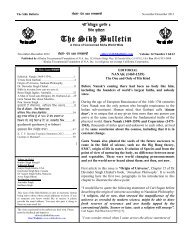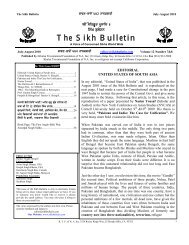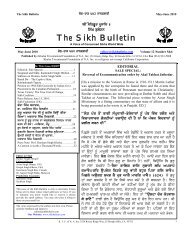Selected Editorials - The Sikh Bulletin
Selected Editorials - The Sikh Bulletin
Selected Editorials - The Sikh Bulletin
You also want an ePaper? Increase the reach of your titles
YUMPU automatically turns print PDFs into web optimized ePapers that Google loves.
P. 138 Babur and the sack of Saidpur, “…but the nature of the reference points to the 1524 capture of<br />
Lahore, not to the 1520 sack of Saidpur…<strong>The</strong> same cannot, however, be said for the claim that Guru<br />
Nanak actually met Babur…It cannot be ruled out as completely impossible, but it certainly appears to be<br />
most unlikely”.<br />
P. 142 Visits to Multan, “As they stand, however, all of the accounts which describe Multan visits must<br />
be rejected”.<br />
Kindest comment I can make is that Mr. McLeod studied the philosophy of Guru Nanak not from the<br />
only authentic source we have, the Guru Granth Sahib, but observing as it was incorrectly practiced by<br />
the <strong>Sikh</strong>s when he was in Punjab and unfortunately incorrectly practiced today in every Gurdwara in<br />
the world and the worst of all places, Darbar Sahib in Amritsar. He compounded this error by failing<br />
to recognize the fallacy in and relying on the Janamsakhis that had distorted Guru Nanak’s message<br />
by miraculous tales that had turned me off <strong>Sikh</strong>ism in my early teenage years since these Janamsakhis<br />
were the source for me to learn Panjabi at home because the regular school education was in Hindi,<br />
the place of my early childhood education being District Ganganagar of Bikaner State of a Hindu<br />
Raja, Maharaja Ganga Singh.<br />
Hardev Singh Shergill<br />
*****<br />
EDITORIAL<br />
ORIGINAL SOURCES OF DASAM GRANTH REVEALED<br />
[Editorial from November-December 2009 <strong>Sikh</strong> <strong>Bulletin</strong>]<br />
]<br />
This issue of <strong>The</strong> <strong>Sikh</strong> <strong>Bulletin</strong> is primarily dedicated to the original research done on the origins of<br />
Dasam Granth by S. Dalbir Singh M. Sc. of New Delhi, India. His entire book ‘bicqR nwtk gRMQ /<br />
AKauqI dsm gMRQ dI AslIXq’ (Dasam Granth-di-Asleeyat), published in August 2009, is included in<br />
this issue. Also included is an article by Dr. Gurmel Singh Sidhu of Fresno State University, Fresno,<br />
California, ‘crcq dsm gRMQ ikvyN hoNd ivc AwieAw ieiqhwsk q`Q Aqy pRmwx’ which, like Dalbir<br />
Singh’s work, is very timely and an eye opening research.<br />
S. Dalbir Singh’s lengthy research resulted in him identifying poet Shyaam (Kabi Shyaam), poet Raam<br />
(Kabi Raam) and poet Kaal (Kabi Kaal) as the three authors of Dasam Granth, all worshippers of<br />
Mahakal-Kalka, but not Guru Gobind Singh and the following four Hindu granths as sources of<br />
everything included in the so called Dasam Granth:<br />
1. Shrimadd Bhagwat-sudha-sagar (Shuksagar), Gita Press<br />
2. Shiv Puran, Gita Press<br />
3. Markandey Puran, Gita Press<br />
4. Shri Durga Sapatshti, Gita Press<br />
Until now many people, who did not acknowledge the entire Dasam Granth as the work of Guru Gobind<br />
Singh, believed some writings to be his because ‘they did not conflict with Gurbani’, a very poor excuse.<br />
If in spite of this incontrovertible proof produced by S. Dalbir Singh people in position of authority still<br />
want to believe in the three banis used for khande-di-pahul and nitnem, I am afraid, there is not much<br />
hope for the renaissance in <strong>Sikh</strong>i which is urgently needed.<br />
Recently during Jathedar Darshan Singh vs. Gurcharanjit Singh Lamba controversy, Tarsem Singh,<br />
President, Dharam Parchar Committee of Delhi <strong>Sikh</strong> Gurdwara Management Committee advised against<br />
criticism of those three banis. That is no surprise. In 2004 I had an occasion to meet with S. Paramjit<br />
52
















